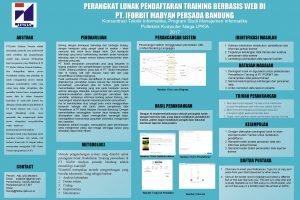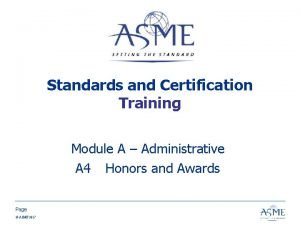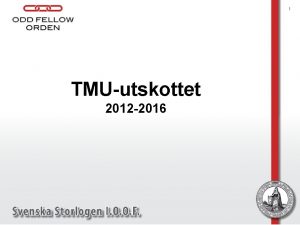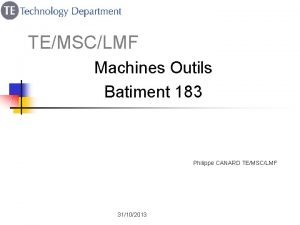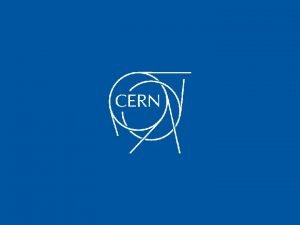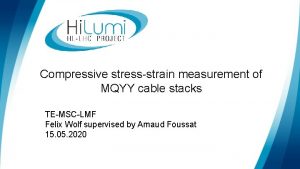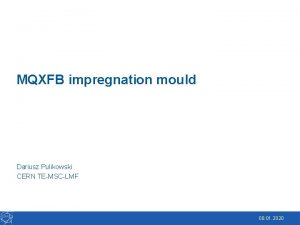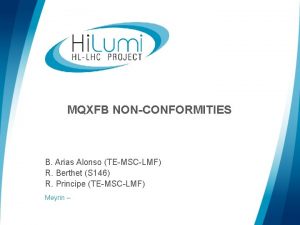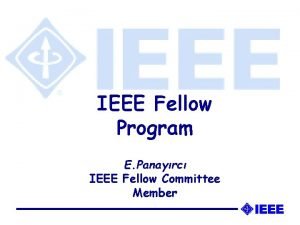Status update on fellow activities TEMSCLMF Student fellow



















- Slides: 19

Status update on fellow activities TE-MSC-LMF Student & fellow meeting Felix Wolf (LMF fellow since 10. 2018), supervised by Arnaud Foussat 18. 01. 2019

Content Tensile test for ultimate strength investigation of marked polyimide films by wrapping machine Investigation of mechanical degradation mechanism onto the quench heater insulation to Nb 3 Sn coil Capacitive load gauge development for magnet application Mechanical characterisation by semi-standardized tests of the Nb 3 Sn Rutherford cable insulation system at RT and cryogenic temperature Felix Wolf 18/01/2019

Tensile test for ultimate strength investigation of marked polyimide films by wrapping machine Felix Wolf 18/01/2019

Tensile test for ultimate strength investigation of marked polyimide films by wrapping machine Insulation machine for Nb-Ti Rutherford cables in building 180 (left) and insulated Rutherford cable (right). Objective: The impact of the imprint to the mechanical strength of the polyimide film was investigated. Therefore new (virgin) and marked samples have been investigated in a uniaxial tensile test machine without extensometry in order to define the setting limits to be applied on the wrapping machine. Felix Wolf 18/01/2019

Tensile test for ultimate strength investigation of marked polyimide films by wrapping machine Tensile test samples a) Samples for tensile test a) Polyimide film Kaneka Apical 100 AV with a thickness of 25. 4 µm, b) Polyimide film Kaneka Apical 100 AV with a thickness of 25. 4 µm deformed, c) Polyimide film Kaneka Apical 200 AV with a thickness of 50. 8 µm and d) Polyimide film Kaneka Apical 200 AV with a thickness of 50. 8 µm deformed. b) c) d) Photograph of the tensile test samples (a) - (d). Force gauge Polyimide film Tensile test Uni-axial tensile tests without extensometry to measure the ultimate tensile force of the polyimide films tensile test machine Mecmesin Versa. Test 550 lb (max. 2. 5 k. N) minimal constant stroke rate of 12 mm/min force recorded with the Mecmesin advanced force gauge (AFG) 2500 N 2 x Protection tape Grip Tensile test machine Pin Tensile test machine with force gauge (left) and detail view of the grip as well as schematic sketch of the clamping. Felix Wolf 18/01/2019

Tensile test for ultimate strength investigation of marked polyimide films by wrapping machine Results of the tensile test (a) 25. 4 µm new #1 a Force at beak [N] 64. 2 Rm [MPa] 229. 8 (b) 25. 4 µm deformed #1 b Force at beak [N] 55. 4 Rm [MPa] 198. 3 Reduction [MPa] Reduction [%] (c) 50. 8 µm new #1 c* Force at beak [N] 126. 0 Rm [MPa] 225. 5 (d) 50. 8 µm deformed #1 d Force at beak [N] 108. 9 Rm [MPa] 194. 9 Reduction [MPa] Reduction [%] * Sample was broken close to the grip #2 a 57. 8 206. 9 #2 b* 64. 2 229. 8 #2 c 120. 6 215. 8 #2 d 100. 0 179. 0 #3 a* 64. 2 229. 8 #3 b 63. 2 226. 2 #3 c 105. 4 188. 6 #3 d* 103. 5 185. 2 #4 a 62. 2 222. 6 #4 b* 49. 5 177. 2 #4 c* 126. 6 226. 6 #4 d 112. 3 201. 0 #5 a 60. 3 215. 8 #5 b 64. 7 231. 6 #5 c 118. 7 212. 4 #5 d 105. 9 189. 5 Average 61. 7 221. 0 Average 59. 4 212. 6 -8. 4 -3. 8 Average 119. 5 213. 8 Average 106. 1 189. 9 -23. 9 -11. 2 SD 2. 73 9. 79 SD 6. 70 23. 98 SD 8. 56 15. 32 SD 4. 75 8. 50 Result: • The ultimate stress of the 25 µm tape is reduced in average by 3. 8 % to (212. 6 MPa ± 24 MPa) • The ultimate stress of the 50 µm tape is reduced in average by 11. 2 % to (189. 9 MPa ± 8. 5 MPa) Felix Wolf 18/01/2019

Investigation of mechanical degradation mechanism onto the quench heater insulation to Nb 3 Sn coil Felix Wolf 18/01/2019

Investigation of mechanical degradation mechanism onto the quench heater insulation to Nb 3 Sn coil Introduction Findings on MBHP 001 - CR 06 -07 Initial insulation resistance in range of ∼ 2 -3 GOhms. Direct shorts provoked in collared coil state was found in same cross sections on paired coils, residual resistance of few Ohms. All in LF strip region Type of direct short defect created in extended Hi-pot test on CR 07, ( hole diam 2 mm, dumped E tot > 1 k. J) Short after successive C bank discharges in CR 06 Last discharge before burn through Short detail after peeling test Courtesy of Jan Petrik, 11/01/2019 https: //indico. cern. ch/event/778100/ 8 Felix Wolf 18/01/2019

Investigation of mechanical degradation mechanism onto the quench heater insulation to Nb 3 Sn coil Compressive load Objective: Applied load (0 -90 MPa) Press tool Multilayer insulation to ground (8 x 125µm) Quench heater (~30µm) on polyimide film (50µm) Impregnation (CTD-101 K) Test: Multilayer insulation to ground (8 x 125µm) Press support Impregnation Cable 18 stack 75 mm 180 k. N hydraulic press, equipped with calibrated load cells Burster type 8526 (0200 k. N) Steel press tool, insulated with multilayer 0. 125 mm polyimide film Electrical measurement device (Megga MIT 1025) Optional V 11 T Nb 3 Sn Rutherford cable (H 150 C 02 244 A) Mica insulation + fibre glass braiding (identical to coil 108) 18 -stack with cancelling keystone angle Impregnated quench heater (11 T Non. Conform 1 st Trackwise piece 08. 03. 2018) Test machine: Quench heater on polyimide film Compressive test + online leakage current measurement Sample: Reacted cable 18 -stack Study of failure mechanism of the insulation system between quench heater and cable under compressive load Test with non-impregnated quench heater to investigate the effect of epoxy crack growing Felix Wolf 18/01/2019

Investigation of mechanical degradation mechanism onto the quench heater insulation to Nb 3 Sn coil Status of sample preparation for compressive load scenario ü Ceramic binder curing ü Reaction heat treatment q Cycle 20 o. C/h to 650 o. C (20 h) (Bldg. 927) Impregnation (ongoing) q Cycle 80 o. C (1 h), 150 o. C (2 h) New mould to apply radial and transversal compression Polymer-Lab. (771) Open mould enables ceramic binder application RHT mould with clearance variation for up to 18 cables First tests under load with electrical test equipment (Megga MIT 1025) foreseen in the coming week Impregnation mould with prepared Felix Wolf 18/01/2019 sample

Investigation of mechanical degradation mechanism onto the quench heater insulation to Nb 3 Sn coil 3 Point bending test Applied Load (0 -1000 N) Objective: Multilayer insulation to ground (8 x 125µm) Reacted cable 2 -stack Impregnation (CTD-101 K) Quench heater (~30µm) on polyimide film (50µm) Sliding contact Steel bar (Stainless steel 3 mm) 11 T Nb 3 Sn Rutherford cable (H 150 C 02 244 A) Mica insulation + fibre glass braiding (identical to coil 108) 2 -stack with cancelling keystone angle impregnated quench heater (small scale production for the test with PCIB lab) Test machine: 3 Point bending test + online leakage current measurement Sample: Applied Load Test: Multiplayer insulation to ground (8 x 125µm) V Study the failure mechanism of the insulation between quench heater and cable under mixed load (compression, shear, bending) Collaboration with TE-EN-MME Electrical measurement device (Megga MIT 1025) Optional Test with non-impregnated quench heater to investigate the effect of epoxy crack growing Felix Wolf 18/01/2019

Investigation of mechanical degradation mechanism onto the quench heater insulation to Nb 3 Sn coil Status of sample preparation for 3 point bending test ü Quench heater production ü Ceramic binder curing ü Production in the CERN PCB-Lab (EP -DT-EF) Cycle 80 o. C (1 h), 150 o. C (2 h) Reaction heat treatment Open mould enables ceramic binder application RHT mould with clearance variation for 3 two stacks Cycle 20 o. C/h to 650 o. C (20 h) q Impregnation (ongoing) q First bending tests in combination with electrical test equipment (Megga MIT 1025) foreseen in Feb. 2019, depending on EN-MME machine availability Impregnation mould with prepared sample and shims for clearance adjustment Felix Wolf 18/01/2019

Capacitive load gauge development for magnet application Literature review, knowledge transfer, manufacturing, validation and optimisation Felix Wolf 18/01/2019

Capacitive load gauge development for magnet application Literature review and knowledge transfer ü Collection of all available documentation about work on capacitive gauges at CERN ü Knowledge transfer with Michel Andre Parent who was involved in the manufacturing process of capacitive gauges at CERN 20 year’s ago ü “Sandwich” type capacitive force transducer design. [I. Vanenkov, Internal Note 96 -14, 1996] Test of existing data acquisition system and Lab. View code for sensor read out Schematic layout of the data acquisition system. [N. Siegel et al. “LHC PROJECT REPORT 173”, 1998] Felix Wolf 18/01/2019

Capacitive load gauge development for magnet application Manufacturing, validation and optimisation Manufacturing ü Tools available ü Sensor production q Validation of the produced sensors q Definition of sensor limitations Documentation q Manufacturing procedure of Capacitive gauges (ongoing) Polyimide film 316 LN Metallic sheet V 1 V 2 Glue 50 µm 25 µm 50 µm Layout of a 5 layer sensor Capacitive gauge manufacturing Optimisation Sensitivity to manufacturing parameter ü Tool qualification at EN-MME q Further steps to be defined Documentation of the capacitive gauge manufacturing process to provide a manufacturing procedure Felix Wolf 18/01/2019

Mechanical characterisation by semistandardized tests of the Nb 3 Sn Rutherford cable insulation system at RT and cryogenic temperature Felix Wolf 18/01/2019

Mechanical characterisation by semi-standardized tests of the Nb 3 Sn Rutherford cable insulation system at RT and cryogenic temperature Insulation system of the Nb 3 Sn Rutherford cable: 1 cm Non-reacted Nb 3 Sn Rutherford cable with insulation System, consisting out of C-shaped Mica and a fiber glass braiding. Reacted and ceramic binder cured Nb 3 Sn Rutherford cable sample with fiber glass, MICA and MICA carry grid (out of fiber glass) and stainless steel core. Felix Wolf 18/01/2019

Mechanical characterisation by semi-standardized tests of the Nb 3 Sn Rutherford cable insulation system at RT and cryogenic temperature Next steps Sample basic material q Manufacturing, to be defined S 2 Glass + Epoxy Mica 122 µm (@5 MPa) n times insulation sandwich Possible sample scheme made out of a fiber glass and MICA sandwich. Foreseen tests for 2019 q Tensile test (to determine stiffness, yield strength σ, elastic strain limit ε, ultimate strength) [ASTM D 3039] q Mixed mode (shear & compression) [S. Nishijima et al. , “Stress analysis in shear/compression test”, Cryogenics 35, 1995] q Further tests and test matrix to be defined Test institutes / laboratories able to measure at 77 K q To be defined Guide line: ASTM D 4762 -08 “Standard Guide for Testing Polymer Matrix composite Materials” ASTM D 3039 “Standard test Method for Tensile Properties of Polymer Matrix Composite Materials” P. E. Fabian, et al. , “Shear/compressive properties of candidate ITER insulation systems at low temperatures ”, Cryogenics 35, 1995. R. Prokopec , et al. , “ Qualification of the resin for the ITER TF coil insulation”, Fusion Engineering and Design 86, 2011. X. Huang, et al. , “ Inter laminar Sher Strangth Property of te Glass Fiber/Polyimide Reinforced Epoxy Resin for ITER Feeder Mock -ups”, IEEEE Trans. On Apppl. Supercond. 24, 2014 Felix Wolf 18/01/2019

Thank you for your attention. Felix Wolf 18/01/2019
 Database backup and recovery techniques
Database backup and recovery techniques Project status update examples
Project status update examples Fsu freight status update
Fsu freight status update Indoor sports and outdoor sports
Indoor sports and outdoor sports Primary and support activities
Primary and support activities Tertiary activities definition
Tertiary activities definition The statement of cash flows helps users
The statement of cash flows helps users Customer roles in service delivery
Customer roles in service delivery Little fellow
Little fellow Welcome phones
Welcome phones Fellow lpkia
Fellow lpkia Ieee fellow nomination
Ieee fellow nomination Clarence filsfils
Clarence filsfils Ieee fellow requirements
Ieee fellow requirements Odd fellow orden
Odd fellow orden Microsoft technical fellow
Microsoft technical fellow Asme fellow nomination
Asme fellow nomination Poor little black fellow summary
Poor little black fellow summary Odd fellow medlemsregister
Odd fellow medlemsregister Preambulatory clauses examples
Preambulatory clauses examples










